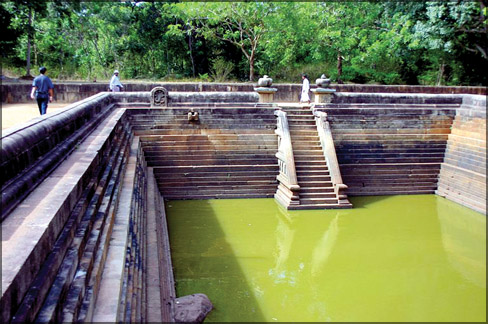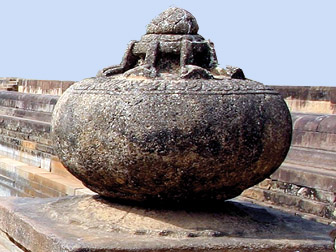Hiritage Splendours

The beautiful twin ponds of Anuradhapura
When we travel in the ancient cities of Sri Lanka such as
Anuradhapura and Polonnaruwa, we come across constructions which are
outstanding feats of engineering as well as rare architectural and
artistic beauties.
Although our country's ancient cities are not lacking in such
marvels, there are some which are just a little bit more outstanding
than the others.
All would agree that the Kuttam Pokuna is one such enginering,
architectural and artistic marvel. This amazing hydraulic engineering
creation of the ancient Sinhalese is found in Anuradhapura close to the
Abhayagiri Dagoba. Known as Kuttam Pokuna (Twin Ponds - kuttama being
the Sinhala word for pair), this is believed to be one of the best
specimens of bathing tanks (pools) in ancient Sri Lanka. This is the
reason for their prime position despite the area having about 20 more
bathing ponds. What is most impressive about the ponds is that they are
not only functional, but also beautiful.
 |
|
The steps
leading down to the bottom of the pool |
The Twin Ponds were built during the 6th-8th centuries, probably for
the use of kings and other royalty of the era. But most historians
believe that they would have been used only by the monks of the
Abhayagiri Vihara as only they lived close to these ponds.
Another unique feature of this construction is that although the two
ponds seem identical, one is actually larger than the other (by about 40
ft. in length). The larger pool, which is to the north, is 132ft by 51
ft, while the smaller pool to the south is 91ft by 51 ft. However, they
appear the same due to their positioning. The larger pool is 18ft in
depth while the smaller pool is 14ft in depth. Some historians also
believe that the two ponds belong to two periods.
The pools are done in granite slabs right down to the bottom and
along the sides. An enclosing wall had also been built around the pool.
Flights of steps leading down to the bottom of the pool are found on
both ends of the pool.
These are decorated with punkalas, the traditional pots of abundance
found in most Sinhala architecture, and scroll designs. Embankments had
also been constructed to facilitate monks to bathe using pots or other
utensils.
 |
|
The ponds are
decorated with Punkalas |
The water that fed the ponds is believed to have flown first into a
filtering basin made of rock.
Then it ran through the mouth of a dragon (makara) and a lion's head
into the smaller pond. An underground conduit fed the larger pond.
The water was emptied in a similar fashion through a point at the
bottom of the smaller pond. At the far end of the Kuttam Pokuna was a
system to trap mud and dirt. Water flew into a pit, where the mud and
dirt sank to the bottom. It ensured a supply of clean water into the
ponds. Shallow pools had also been built to cool one's feet before
diving into the ponds.
A beautiful carving of a five-hooded cobra could be seen at the
Kuttam Pokuna. It is not clear whether this was carved to invoke the
blessings of the cobra for safety of the pond or because the ancient
people treated the cobra as the guardian of water. Small figures of
fish, a conch, a crab and a dancing woman were also discovered at the
bottom of the pond.
One of the biggest restoration projects of that nature carried out in
Sri Lanka was regarding the Kuttam Pokuna and Dr. Senarat Paranavithana
was actively involved in the restoration of the ponds. |

